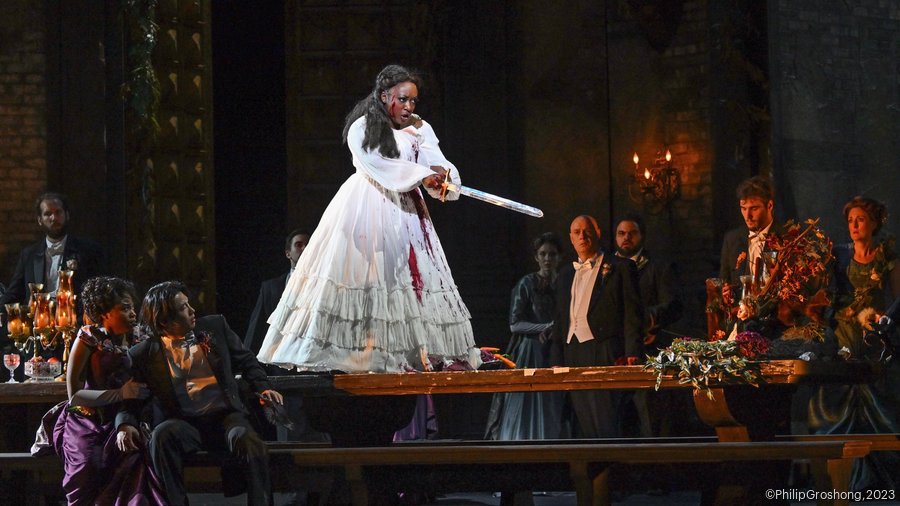Listen to this article 4 min
When we first meet Lucia in Cincinnati Opera’s “Lucia di Lammermoor,” which opened June 22 in Music Hall, the young woman is waiting in the moonlight by a fountain for her lover, Edgardo. Lucia is frightened. She reveals she saw a slain girl’s ghost near the fountain, and the water had turned blood red.
That moment, sung with touching emotion by soprano Raven McMillon, set the tone for Donizetti’s tragic opera and anticipated the chilling “Mad Scene” that Lucia would sing later.
Returning conductor Renato Balsadonna led a strong cast of singers in “Lucia di Lammermoor” to launch Cincinnati Opera’s 103rd summer festival. Tackling the role of Lucia for the first time, McMillon, a graduate of the University of Cincinnati College-Conservatory of Music, displayed a voice of silvery beauty. While soaring through the challenging vocal pyrotechnics required in this bel canto work, she also conveyed the innocence of the young Lucia, who is bullied by her brother into a marriage of convenience.
Adapted from a novel by Sir Walter Scott, Donizetti’s opera takes place in 17th century Scotland. Cincinnati Opera’s production coming from Indiana University Jacobs School of Music has updated the tale to the Victorian Era.
Lucia is controlled by her brother Enrico in the gloomy Lammermoor Castle, where portraits of Ashton ancestors stare down at her from a towering wall in Lammermoor Hall. In the story, the Ashton clan is in desperate financial need of a good marriage for Lucia.
Unfortunately, Lucia’s true love Edgardo, the only living heir of the Ravenswood clan, is the arch enemy of her brother Enrico.
In his company debut as Edgardo, Argentine tenor Santiago Ballerini displayed an ardent voice and a charismatic stage presence. His passion was believable. Who could resist his proposal, when he dropped to a knee, took out a ring and threw the box over his shoulder?
The couple’s Act I duet was magical. When Edgardo learned of Lucia’s death, his desperation was palpable in his final farewell, sung against a blood-red moon, “Tu che a Dio spiegasti l’ali” (“You have spread your wings to heaven.”)
In the role of Enrico, Anthony Clark Evans wielded a powerful, dark voice and imposing presence as he sought to threaten his sister into marrying the wealthy Lord Arturo Bucklaw. At various points, he grabbed at her and once threw her to the floor.
The family chaplain Raimondo, Griffen Hogan Tracy, communicated with a firm bass, excellent enunciation, and the kind of cool distance of one who offers Lucia sympathy while advising her to accept her fate and marry Arturo.
Surrounded by such people, it’s small wonder she goes mad. In the famous “Mad Scene” as portrayed by McMillon, Lucia roamed the stage as if in a trance to the other-worldly sounds of the glass harmonica, used instead of flute for the first time by the company. (The instrument, originally intended by Donizetti, was performed by Sascha Reckert.)
Perhaps as a nod to her youth, Lucia cradled a doll during her raving, believing it was Edgardo. Her vocal cadenza accompanied by glass harmonica was a stunning feat of seamless leaps, runs and pristine high notes. After her final trills, she collapsed into the arms of her brother, to lengthy ovations from the opening night audience.
Even earlier, McMillon’s beautiful sense of line was evident in Act I, as she communicated the story of the fountain in her aria, “Regnava nel silenzio,” sung with a note of melancholy. It was capped by the precise intonation and impressive coloratura of the ensuing “Quando rapito in estasi,” as she sang of forgetting her sorrows when lost in ecstasy. She is clearly a talent to watch.
In smaller roles, Sahel Salam was fine as the hapless groom Arturo. Terrence Chin-Loy as Normanno and Kayleigh Decker as Alisa made admirable contributions.
The chorus, prepared by Henri Venanzi, added lively color and expression, whether in the opening scene as guards of Lammermoor Castle or as festively dressed wedding guests. Jose Maria Condemi provided lively staging where he could in this traditional production. The post-wedding scene was especially eye-opening, in which the wedding guests descended into a scene of drunken debauchery bathed in red lighting.
The inventive set, featuring a huge, ornate gate to the castle, was designed by Philip Witcomb, who also designed the costumes.
In the pit, Balsadonna drew rich sounds from the Cincinnati Symphony, leading with a sure hand. His pacing breathed and he was in absolute tune with each singer, although balance was a bit heavy at first. The musicians performed wonderfully. Special mention must go to principal harpist Gillian Benet Sella, whose playing was exquisite in the famous harp solo in Act 1.
The updating generally worked, save for the brief reference to William and Mary in the libretto.
Cincinnati Opera’s production of Donizetti’s “Lucia di Lammermoor” repeats at 7:30 p.m. June 24 in Music Hall. Tickets: 513-241-2742, cincinnatiopera.org.
Janelle Gelfand covers the arts for the Courier. Her work is supported by the Rubin Institute for Music Criticism, San Francisco Conservatory of Music, and Ann and Gordon Getty Foundation.
